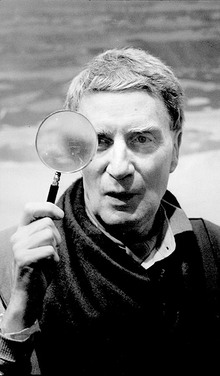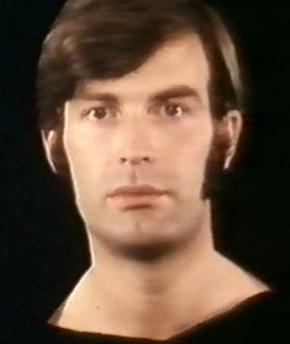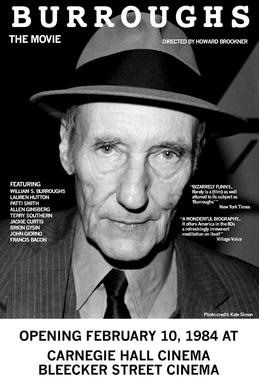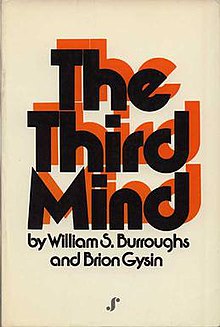
Brion Gysin was a British-Canadian painter, writer, sound poet, performance artist and inventor of experimental devices.

The cut-up technique is an aleatory narrative technique in which a written text is cut up and rearranged to create a new text. The concept can be traced to the Dadaists of the 1920s, but it was developed and popularized in the 1950s and early 1960s, especially by writer William S. Burroughs. It has since been used in a wide variety of contexts.

William Seward Burroughs II was an American writer and visual artist. He is widely considered a primary figure of the Beat Generation and a major postmodern author who influenced popular culture and literature. Burroughs wrote eighteen novels and novellas, six collections of short stories and four collections of essays, and five books have been published of his interviews and correspondences; he was initially briefly known by the pen name William Lee. He also collaborated on projects and recordings with numerous performers and musicians, made many appearances in films, and created and exhibited thousands of visual artworks, including his celebrated "shotgun art".
Chaos magic, also spelled chaos magick, is a modern tradition of magic. Emerging in England in the 1970s as part of the wider neo-pagan and esoteric subculture, it drew heavily from the occult beliefs of artist Austin Osman Spare, expressed several decades earlier. It has been characterised as an invented religion, with some commentators drawing similarities between the movement and Discordianism. Magical organizations within this tradition include the Illuminates of Thanateros and Thee Temple ov Psychick Youth.

Naked Lunch is a 1991 surrealist science fiction drama film written and directed by David Cronenberg and starring Peter Weller, Judy Davis, Ian Holm, and Roy Scheider. It is an adaptation of William S. Burroughs's 1959 novel of the same name, and an international co-production of Canada, Britain, and Japan.

The Beat Hotel was a small, run-down hotel of 42 rooms at 9 Rue Gît-le-Cœur in the Latin Quarter of Paris, notable chiefly as a residence for members of the Beat poetry movement of the mid-20th century.

Mohamed Hamri, commonly known as Hamri, was a Moroccan painter, restauranteur, and author; he helped write and produce Sufi music. Self-described as "The painter of Morocco," Hamri was one of the few Moroccans to participate in the Tangier Beat scene.

Antony Balch was an English film director and distributor, best known for his screen collaborations with Beat Generation author William S. Burroughs in the 1960s and for the 1970s horror film, Horror Hospital.

Exterminator! is a short story collection written by William S. Burroughs and first published in 1973. Early editions label the book a novel. It is not to be confused with The Exterminator, another collection of stories Burroughs published in 1960 in collaboration with Brion Gysin.
The Nova Trilogy or The Cut-up Trilogy is a name commonly given by critics to a series of three experimental novels by William S. Burroughs.
Spam poetry, sometimes called spoetry, is poetic verse composed primarily from the subject lines or content of spam e-mail messages.

Ira Cohen was an American poet, publisher, photographer and filmmaker.

Ali's Smile: Naked Scientology is a collection of essays and a short story by American Beat writer William S. Burroughs (1914–1997). First published in 1971 as the short story "Ali's Smile", the book eventually contained a group of previously published newspaper articles as well, all of which address Scientology. Burroughs had been interested in Scientology throughout the 1960s, believing that its methods might help combat a controlling society. He joined the Church of Scientology later in the decade. However, he became disenchanted with the authoritarian nature of the organization. In 1970 Burroughs had published a "considered statement" on Scientology's methods because he felt they were significant enough to warrant commentary. These pieces were later gathered together into Ali's Smile: Naked Scientology, which religious studies scholar Hugh B. Urban describes as a "nonscholarly popular exposé of Scientology". Burroughs's texts argue that while some of Scientology's therapies are worthwhile, the dogmatic nature of the group and its secrecy are harmful.
Dodie Bellamy is an American novelist, nonfiction author, journalist, educator and editor. Her book Cunt-Ups (2001) won the 2002 Firecracker Alternative Book Award. Her work is frequently associated with that of the New Narrative movement in San Francisco and fellow writers Robert Glück, Dennis Cooper, Kathy Acker, Kevin Killian, and Eileen Myles.

The Dreamachine, invented in 1959 by Brion Gysin and Ian Sommerville, is a stroboscopic flickering light art device that produces eidetic visual stimuli.

The Process is a novel by Brion Gysin which was published in 1969. Gysin was a painter and composer, and also collaborated with Beat Generation author William S. Burroughs on many occasions. The Process was his first full-length novel.

Sinclair Beiles was a South African beat poet and editor for Maurice Girodias at the Olympia Press in Paris. He developed along with William S. Burroughs and Brion Gysin the cut-up technique of writing poetry and literature. He won the 1969 Ingrid Jonker Prize for poetry for his collection, Ashes of Experience.
Auerhahn Press was a publishing company in San Francisco between 1959 and 1965, founded by printer-poet Dave Haselwood. The company published many key poets of the San Francisco Renaissance.

Ian Sommerville was an electronics technician and computer programmer. He is primarily known through his association with William S. Burroughs's circle of Beat Generation figures, and lived at Paris's so-called "Beat Hotel" by 1960, when they were regulars there, becoming Burroughs's lover and "systems adviser".

Burroughs is a 1983 documentary film directed by Howard Brookner about the Beat Generation writer William S. Burroughs.















